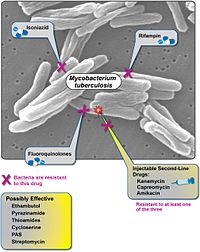
Photo from wikipedia
Purpose Multidrug-resistant tuberculosis threatens global tuberculosis care and prevention and remains a major public health concern in many countries. In 2016, there were an estimated 490,000 cases of MDR and… Click to show full abstract
Purpose Multidrug-resistant tuberculosis threatens global tuberculosis care and prevention and remains a major public health concern in many countries. In 2016, there were an estimated 490,000 cases of MDR and 110,000 more cases resistant to rifampicin (RR TB). Ethiopia is among the highest MDR TB burden countries according to the WHO. This study aims to describe the magnitude, trends, and geographical distribution of the drug-resistant TB in Bale Zone during study period. Materials and Methods A descriptive study was conducted. We reviewed secondary data of MDR and RR TB cases from July 2014 to June 2018. Data were extracted from the Bale zone health management information system database, checked for completeness, and then analyzed for trends over time. Results A total of 43 cases (67.4% female) of drug-resistant TB were reviewed, with 30.2% MDR and 69.8% RR TB. The prevalence of drug-resistant tuberculosis cases declined from 0.81% to 0.62% (trend χ2=2.18; P=0.14) during study period. Among drug-resistant TB cases, RR TB increased from 52.6% to 81% (trend χ2=6.5; P=0.01). Conclusion Drug-resistant TB decreased over the period studied, although the trend did not reach statistical significance. These trends may reflect the efficacy of TB control programs to reduce drug-resistant TB transmission, as well as improved RR TB detection due to increased use of molecular diagnostic platforms like GeneXpert MTB/RIF.
Journal Title: Infection and Drug Resistance
Year Published: 2021
Link to full text (if available)
Share on Social Media: Sign Up to like & get
recommendations!